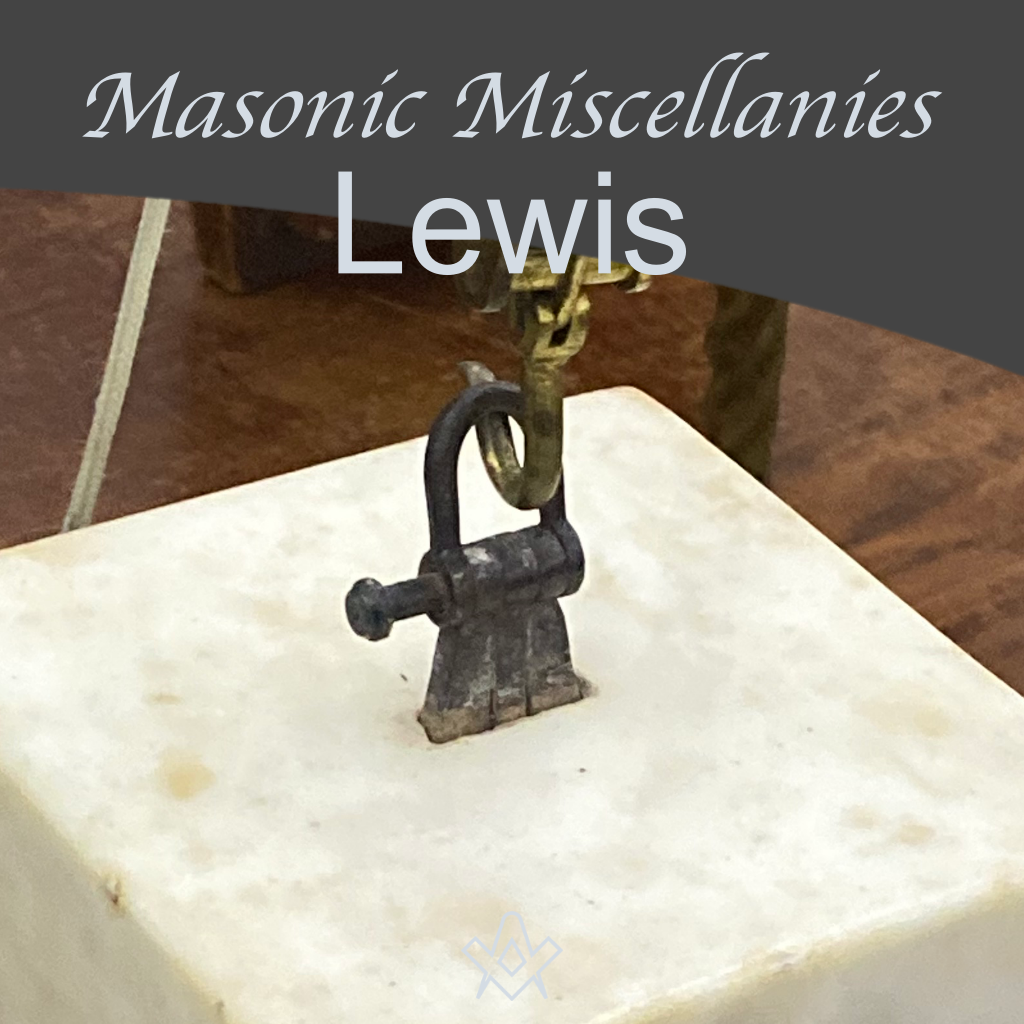LEWIS. The son of a Mason; some are inclined to limit the term to a son born to a Mason, excluding a son born to a man who afterwards became a Mason.
A Lewis in England has no rights legally conferred as such. He cannot be initiated under 21, except by Dispensation, but is conceded the priority in ballot and initiation over another Candidate not a Lewis.
In Scotland, a Lewis can be initiated at 18. As an Operative Instrument, a Lewis is defined as pieces of iron dovetailed into a stone whereby the stone can be raised to great heights, sometimes called a strong grip, or cramp, as depicted in the Mark Degree.
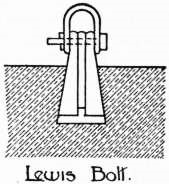
A Stonemason’s Lewis
IMAGE LINKED: Encyclopaedia Britannica, 11th Edition, Volume 17, 1911 Attribution 4.0 International (CC BY 4.0)
The words ‘Lewis’ and Louveteau, which, in their original meaning, import two very different things, have in Masonry an equivalent signification – the former being used in English, the latter in French, to designate the son of a Mason.
The English word ‘Lewis’ is a term belonging to operative Masonry, and signifies an iron cramp, which is inserted in a cavity prepared for the purpose in a large stone, so as to give attachment to a pulley and hook, whereby the stone may be conveniently raised to any height, and deposited in its proper position.
In this country [USA] the Lewis has not been adopted as a symbol in Freemasonry, but in the English ritual it is found among the emblems placed upon the tracing board of the Entered Apprentice, and is used in that degree as a symbol of strength, because, by its assistance, the operative Mason is enabled to lift the heaviest stones with a comparatively trifling exertion of physical power.
Extending the symbolic allusion still further, the son of a Mason is in England called a Lewis, because it is his duty to support the sinking powers and aid the failing strength of his father, or, as Oliver has expressed it;
‘to bear the burden and heat of the day, that his parents may rest in their old age, thus rendering the evening of their lives peaceful and happy’.
By the Constitutions of England, a Lewis or son of a Mason may be initiated at the age of eighteen, while it is required of all other candidates that they shall have arrived at the [more] mature age of twenty-one.
The Book of Constitutions had prescribed that no lodge should make ‘any man under the age of twenty-one years, unless by a dispensation from the Grand Master or his Deputy’.
The Grand Lodge of England, in its modern regulations, has availed itself of the license allowed by this dispensing power, to confer the right of an earlier initiation on the sons of Masons.
The word ‘louveteau’ signifies in French a young wolf.
The application of the term to the son of a Mason is derived from a peculiarity in some of the initiations into the Ancient Mysteries.
In the mysteries of Isis, which were practiced in Egypt, the candidate was made to wear the mask of a wolf’s head.
Hence, a wolf and a candidate in these mysteries were often used as synonymous terms.
Macrobius, in his Saturnalia, says, in reference to this custom, that the ancients perceived a relationship between the sun, the great symbol in these mysteries, and a wolf, which the candidate represented at his initiation.
For, he remarks, as the flocks of sheep and cattle fly and disperse at the sight of the wolf, so the flocks of stars disappear at the approach of the sun’s light.
The learned reader will also recollect that in the Greek language ‘lukos’ signifies both the sun and a wolf.
Hence, as the candidate in the Isiac Mysteries was called a wolf, the son of a Freemason in the French lodges is called a young wolf, or a louveteau.
The louveteau in France, like the Lewis in England, is invested with peculiar privileges.
He is also permitted to unite himself with the Order at the early age of eighteen years.
The baptism of a louveteau is sometimes performed by the lodge of which his father is a member, with impressive ceremonies.
The infant, soon after birth, is taken to the lodge room, where he receives a Masonic name, differing from that which he bears in the world; he is formally adopted by the lodge as one of its children; and should he become an orphan, requiring assistance, he is supported and educated by the Fraternity, and finally established in life.
In this country [USA], these rights of a Lewis or a louveteau are not recognized, and the very names were, until lately, scarcely known, except to a few Masonic scholars.
Article from The Builder – November 1922

Recent Articles: Masonic Miscellanies
 Masonic Miscellanies - The Amulet of the Ladder Explore the cosmic significance of the Ladder in ancient Egyptian mythology through Wallis Budge's "Egyptian Magic." Discover how this profound symbol bridges the mortal and divine, encapsulating the Egyptians' fervent afterlife aspirations with a blend of myth, magic, and material culture. Dive into the celestial ascent of Osiris and mortal souls. |
 Masonic Miscellanies - Adulterine Gilds Guilds, the associations that shaped medieval European society, were more than just organizations of artisans and merchants. They played a vital role in the economic and social development of towns and cities. This exploration delves into the intriguing concept of adulterine gilds and their interconnectedness with guilds, offering insight into the significance of legal authorization and recognition in medieval Europe. |
 Masonic Miscellanies - Masonic Orb Discover the fascinating world of Masonic ball watch fobs, intricately crafted with tiny pyramids that form a cross when opened. These decorative accessories were all the rage in the late 1800s and early 1900s, and they still hold a certain allure today. Explore the different varieties and symbols found on these unique pieces that carry deep Masonic meaning. |
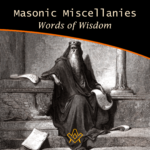 Masonic Miscellanies – Words of Wisdom Uncover timeless wisdom from King Solomon to Albert Pike in our latest Masonic Miscellanies, a treasure trove of insights for Masons. Journey through the ages and glean inspiring sayings, reflecting on their profound influence on Masonic principles. An enriching read for the enlightened. |
 Masonic Miscellanies - Symbolism of the Right Hand Unlock the enigmatic realm of Freemasonry as we delve into its age-old symbols, rituals, and philosophies. This thought-provoking exploration, drawn from Mackey's Revised Encyclopedia of Freemasonry, focuses on the iconic 'right hand' symbol - its rich history, universality, and profound significance. |
 Masonic Miscellanies - Order of the Secret Monitor Unveil the mystery of Freemasonry with 'The Order of the Secret Monitor'. Discover this lesser-known appendant order, its unique rituals, and the profound teachings it offers. Explore the bonds of friendship and brotherhood it fosters, all wrapped in an intriguing cloak of mystery. Your journey into the depths of Masonic wisdom begins here. |
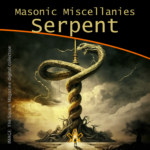 Masonic Miscellanies - The Symbol of the Serpent As a symbol, the serpent obtained a prominent place in all the ancient initiations and religions. |
 Masonic Miscellanies - The Four Veils in Royal Arch Masonry What are the four veils in Royal Arch Masonry? And what is the 'Ceremony of Passing the Veils'? Although common throughout Scotland, Ireland and the United States, it is mostly unknown in England, presently only worked in the Province of Bristol. ( and by dispensation ) |
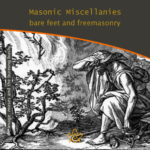 Masonic Miscellanies - Bare feet and Freemasonry A candidate for initiation into a Masonic Lodge often finds the requirements which he/she must fulfil somewhat odd. The mode of preparation often remains a puzzle, since the ritualistic explanation is not offered in full. Why are we 'slipshod' or "bare-footed" in Masonic Ritual? |
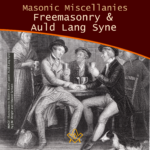 Masonic Miscellanies – Freemasonry and Auld Lang Syne Millions of people throughout the world will sing Auld Lang Syne to see out the Old Year. Few will know all the words, fewer still know what they mean, or that there is a link to Freemasonry. |
 Masonic Miscellanies - The Mosaic Pavement - why mosaic, why pavement? We are all familiar with the black and white chequered flooring of the Masonic lodge but where did it originate? There are a few theories… |
 Masonic Miscellanies – Masonic Master's Carpets Have you got a magic "Masonic Master's Carpet" in your lodge? I say 'magic' with my tongue firmly in my cheek because (as far as I know) these fabulous works of art don't bestow any mystical powers but can bestow some educational ones! However, considering their possible value today, they may magic up some interest (or funds). |
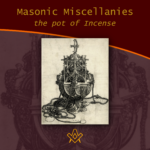 Masonic Miscellanies – The Pot of Incense Just when the pot of incense became an emblem of the third section of the Sublime Degree can not be stated with certainty. It is, apparently, an American invention or addition. But what does it symbolise? |
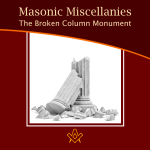 Masonic Miscellanies - The Broken Column Monument The story of the broken column was first illustrated by Amos Doolittle in the "True Masonic Chart" by Jeremy Cross, published in 1819. |
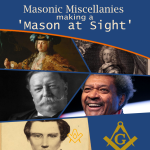 Masonic Miscellanies - Making a 'Mason at Sight' What does it mean to make a 'Mason at sight', and who was made one? |
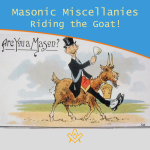 Masonic Miscellanies - Riding the Goat! Many Freemasons will have come across the phrase 'riding the goat', and will no doubt have been the butt of a joke about it (sorry, I couldn't resist!) But what does it mean and where did the phrase come from? |
 Masonic Miscellanies - What are the 'three dots'? Three dots or points in an upright triangular shape ∴ is most commonly known as the 'therefore' sign – so why is it used in Freemasonry? |
 Masonic Miscellanies - Keep Within Compass This month we discover a series of allegorical prints warning us to "Keep within Compass and you shall be sure, to avoid many troubles which others endure." |
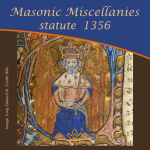 Masonic Miscellanies - statute 1356 Further to the reference in the article – The Builders - 6 - Free-Masons 'a statute was enacted against the Free-masons in 1356' – Regulations for masons who are hewers, on the one hand, and the light masons and setters on the other. |
 Masonic Miscellanies - An Anti-Masonic 'Apron'? The Anti-Masonic 'Apron' was created during the 1832 Presidential election in USA. It was not Ani-masonic. And it was not an apron. Read on to find out what and why it was created. |
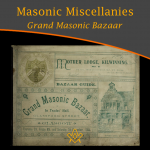 Masonic Miscellanies - Grand Masonic Bazaar (1895) Grand Masonic Bazaar (1895); to raise funds to clear the debt incurred by “Mother Kilwinning” in rebuilding their Lodge. |
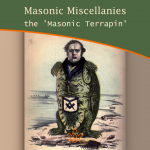 Masonic Miscellanies - the 'Masonic Terrapin' A satirical book from 1851 includes a bizarre caricature of a 'Masonic Terrapin' - all I can say is 'read on'… |
 Masonic Miscellanies - Masonic Bookplates You probably know what a bookplate is for, but did you know that the earliest known book mark/label dates from the reign of Amenhotep III in Egypt around 1391−1353 BCE?! |
 Masonic Miscellanies - Freemasonry & Bees Freemasonry & Bees - what's the buzz? The bee was among the Egyptians the symbol of an obedient people, because, says Horapollo, of all insects, the bee alone had a king. |
 Masonic Miscellanies - The mystery of the Tattooed Freemason In 1894, the body of a drowned man was found in the Bay of San Francisco - what they discovered was amazing. |
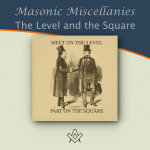 Masonic Miscellanies - The Level and the Square (A Poem) The Level and the Square (A Poem) - "We meet upon the Level, and we part upon the Square – |
 Masonic Miscellanies - The Mystic Tie What is the 'Mystic Tie'? Clue: it's not an item of neckwear! |
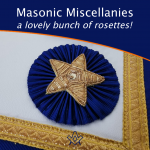 Masonic Miscellanies - A lovely bunch of rosettes! Where did the origin of the use of rosettes on Masonic aprons come from ? |
 Masonic Miscellanies - The Lodge of Sorrow The Lodge of Sorrow - Extracted General Ahiman Rezon, by Daniel Sickles, [1868] |
 Masonic Miscellanies - Memento Mori Memento Mori - a Masonic reminder to make your mark on the world |
 Masonic Miscellanies - A closer look at the Level and the Plumb-rule A closer look at the Level and the Plumb-rule |
 Masonic Miscellanies - The Symbolism of the Gloves The Symbolism of the Gloves and why Freemasons wear white gloves |
 Masonic Miscellanies - Will the real James Anderson please stand up? Will the real James Anderson please stand up? |
 Masonic Miscellanies - The Legend of the Third Degree The most important and significant of the legendary symbols of Freemasonry is, undoubtedly, that which relates to the fate of Hiram Abif. |
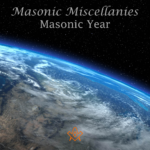 Masonic Miscellanies - Masonic Calendar Why do Freemasons use different 'years' to our regular calendar? |
 Masonic Miscellanies - What is a 'Lewis'? The English word 'Lewis' is a term belonging to operative Masonry, and signifies an iron cramp, which is inserted in a cavity prepared for the purpose in a large stone. |
 Masonic Miscellanies - From J.S.M. Ward Ever wondered why masons had to be 'free' or why we have a Tyler? |
masonic knowledge
to be a better citizen of the world
share the square with two brothers

click image to open email app on mobile device


